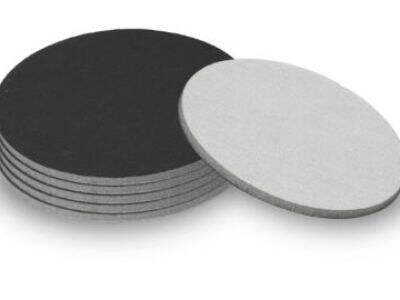उदाहरणका रूपमा, यदि तपाईं कुनै DIY परियोजना गर्दै हुनुहुन्थ्यो, तपाईंलाई कुनै लकड़ी को टुक्रो वा फेरी मेटल सतह सँडिङ्ग गर्नु पर्न सक्छ। सँडिङ्ग सतहलाई चटको बनाउने अर्को महत्वपूर्ण कदम हो जसले पेन्ट वा फिनिश लिन अनुकूल बनाउँछ। त्यसो भए, सँडिङ्गको मामलमा सबैभन्दा राम्रो उपकरण कसरी छनौट गर्नु पर्दछ? तपाईंले सँडिङ्ग बेल्ट वा सँडिङ्ग डिस्क पनि उपयोग गर्न सक्नुहुन्छ। सँडिङ्ग उपकरणका दुई प्रकार राम्रो वा खराब बातहरू राख्छन् र यो सबैले तपाईंको कामको आवश्यकतामा भित्र भएको कामको आधारमा निर्भर गर्छ।
डिस्कहरू र बेल्टहरू: राम्रो र खराब
सँडिङ बेल्टहरू तपाईं ड desk, table, वा ठूलो फर्नीचर जस्ता ठूलो सतहमा काम गर्दै हुने समय मा खूब उपयोगी हुन्। तिनी तपाईंलाई काम धेरै सजिलो बनाउन मदद गर्दछन् र तपाईंले चाहानु भएको समतल परिणाम प्राप्त गर्न सक्नुहुन्छ। यसले तपाईंलाई अन्तिम परिणाम राम्रो देखाउन चाहनुभएको ठूलो कामको लागि एक ठोस विकल्प बन्छ। बस, एक बाटो, यो ध्यान दिनु पर्दछ कि बम्प सँडिङ बेल्टहरू सँडिङ डिस्कबाट धेरै महँगा हुन सक्छ। त्यसो भए, यदि तपाईं बजेटमा समझदार छौं, भर्खरै खरीदी गर्न वा नगर्न पर्दछ।
सँडिङ डिस्कहरू घोर र विवरणको आवश्यकताहरू जस्तै कोनो वा किनाराहरू सँड गर्न छोटो परियोजनाहरूको लागि राम्रो छन्। तिनी सँडिङ बेल्टबाट धेरै सस्तो छन् र धेरै विभिन्न ब्रँडहरू र ग्रिट आकारहरूमा उपलब्ध छन्। ग्रिट सँडपेपरको रूखामा वा नमैमा हो। त्यसैले, सँडिङ डिस्कहरू सँडिङ बेल्टबाट धेरै मुस्किल बन्न सक्छन्, त्यसो भए, तपाईंले त्यसको अनुप्रयोगमा गल्ती नगर्न पर्दछ।
तपाईंको परियोजनाका लागि सही सँडिङ उपकरण कसरी छनौट गर्ने
सैन्डिंग टूल छान्नुभन्दा पहिले यो कुराहरूलाई माथी राख्नु पर्दछ:
सतहको आकार: पहिले तपाईंले सैन्डिंग गर्ने सतहको आकारको बारेमा सोच्नुहोस्। यदि तपाईं ठूलो सतह, जस्तै ठूलो मेज वा डेक सैन्डिंग गर्दै हुनुहुन्छ, भन्दा सैन्डिंग बेल्ट तपाईंको लागि सबैभन्दा राम्रो छ। अनि दूरी तयार गर्न समय नष्ट भइरहेको छैन। तर छोटो वा विस्तृत काम, जस्तै कुर्सीको पैर वा लौही खेलानी सैन्डिंग गर्न, तपाईंलाई सैन्डिंग डिस्कहरूको आवश्यकता पर्दछ।
खराबी: तर्फैँ, सैन्डिंग टूलको खराबीको बारेमा सोच्नुहोस्। सैन्डिंग बेल्ट र डिस्कहरूको लागि खराबीका अलग-अलग स्तरहरू छन्। नम्बर थप्पडै जान्छ, सैन्डपेपर थरथरो हुन्छ, जसले धेरै सामग्रीलाई तेजीमा हटाउन सक्छ। नम्बर १५०० र त्यसबाहेक बढ्दै जान्छ, र उच्च नम्बरले रमाइलो सैन्डपेपर र त्यसैले धेरै शुद्ध अन्तिम परिणाम दिन्छ। यदि उदाहरणको लागि तपाईंले धेरै पुरानो पेन्ट हटाउनु पर्दै भने, तपाईं थप्पडै खराबीबाट शुरू गर्न सक्नुहुन्छ। यदि तपाईं अन्तिम भागलाई धेरै रमाइलो गर्न चाहानुहुन्छ भने, उच्च खराबी प्रयोग गरिन्छ।
सामग्री: अन्तिमको, तपाईंले सन्ड गर्दै छु भनेर कुरा गर्नुहोस्। सामग्रीको प्रकारले तपाईंले चयन गर्नुपर्ने सन्डिङ उपकरण पर्दछ। उदाहरणको लागि, पाटीमा साधारणतया रुखभन्दा भिन्न प्रकार र घर्षण बल आवश्यक पर्दछ। अन्ततः गलत उपकरण प्रयोग गर्नु तपाईंको काम मुस्कराउँदछ र तपाईंले चाहने परिणाम प्राप्त गर्न सक्नुहुनेछ।
कुन उपकरण राम्रो लाग्छ?
तपाईंको परियोजनाको लागि सबैभन्दा राम्रो उपकरण तपाईंले काम गरिरहेको सतह र तपाईंले खोजिरहेको परिणामबाट निर्भर गर्दछ। जब तपाईं ठूलो सतह समाप्त गर्दै हुनुहुन्छ, तपाईंले साधारणतया सन्डिङ बेल्ट चयन गर्न चाहिए। यसले तपाईंलाई काम गर्न तेजी र राम्रो तरीकाले मद्दत गर्दछ। तर छोटो वा ठीक ठीक कामहरूमा, जहाँ तपाईंले सावधानी र शुद्धता आवश्यक पर्दछ, सन्डिङ डिस्कहरू साधारणतया राम्रो छन्। यो तपाईंलाई छिकै ठाउँहरूमा काम गर्न दिन्छ र तपाईंले एउटा ठाउँमा बढी सन्ड गर्ने गर्दैन।
सन्डिङ बेल्ट वा डिस्क
सँडिङ बेल्टहरू मा दोस्रो रोलरहरू पर्यन्त दुर्गम क्षेत्रहरूमा सँडिङ गर्ने एक लूप सँडपेपर राखिएको छ। जब तपाईं उपकरण चालू गर्नुभएको छ, तब बेल्ट रोलरहरूमा घूम्न थाल्छ र तपाईंले यो निर्देशित गर्दै छ, भन्दै सतहमा सँडिङ गर्छ। यसैले सँडिङ बेल्टहरू ठूलो कामहरूमा धेरै उत्पादक हुन्। सँडपेपरको दोस्रो प्रकार सँड पेपर डिस्कहरू हुन्, जसले डिस्क सँडर भन्दा एक यन्त्रमा माउन्ट गर्दछ। यस उपकरणले तपाईंलाई कोनाहरूमा सँडिङ गर्न वा अर्को दुर्गम क्षेत्रहरूमा सँडिङ गर्न सक्षम बनाउँछ।
बेल्ट र डिस्कहरूको तुलना गर्ने
सामान्यतया, सँडिङ बेल्टहरू विस्तृत र फ्लेट सतहहरूको लागि उत्कृष्ट छन्, जबकि सँडिङ डिस्कहरू छोटो किंवा विवरणपूर्ण कामहरूमा कडा पर्दछ। व्यापारिक सँडिङ बेल्टहरू धेरै मूल्यवान छन्, तर ठूलो परियोजनाहरूमा तपाईंलाई स्मूथ फिनिश दिन्छ। सँडिङ डिस्कहरू मूल्यमा कम छन्, कामको धेरै प्रकारहरूमा बहुत लचीला छन्, र धेरै ग्रिटहरूमा आउन्छ। सदैव सतहको आकार, आवश्यक ग्रिट, र सामग्रीको प्रकार निर्धारण गर्न सँडिङ उपकरणको आकार विचार गर्नुहोस्।
यसले तपाईंलाई उपयोगी हुन सक्छ भनेको यसै अर्थो हो, जिसबाट तपाईं आफ्नो DIY परियोजनाहरूमा काम गर्न सक्छ। आफ्नो काममा जस्तै कामहरू छन् त्यसले धेरै किराया लाग्दैन जस्तो कि तपाईं उचित गुणस्तरका उत्पादहरू प्रयोग गरेर आफ्नो काम समाप्त गर्न सक्छ। सही उपकरण र सहि परिश्रमको साथ, तपाईं आफ्नो अर्को परियोजनामा एउटा एउटा चालू र पेशेवर समापन प्राप्त गर्न सक्छ।

 EN
EN
 AR
AR BG
BG HR
HR CS
CS DA
DA NL
NL FI
FI FR
FR DE
DE EL
EL HI
HI IT
IT JA
JA KO
KO NO
NO PL
PL PT
PT RO
RO RU
RU ES
ES SV
SV TL
TL IW
IW ID
ID SR
SR ET
ET MT
MT TH
TH TR
TR FA
FA AF
AF MS
MS GA
GA CY
CY MK
MK EU
EU KA
KA LA
LA NE
NE